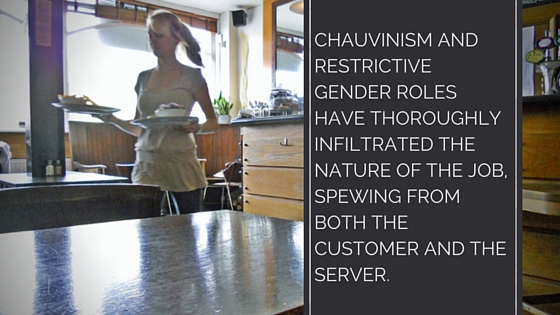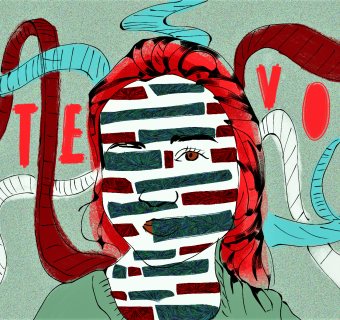Carly Gorelick
Startled, I pivot back, reaching toward the hand that has unashamedly grabbed hold of my hip. “I’m sorry sir but can I help you?” I ask, ripping his fingers off of me while meeting his gaze with a snappy stare. He loosens his grip and I continue to take his order. Turns out that his desire for new ketchup warranted his lingering grip-another lesson for my book, I suppose. The plight of the self-respecting, conflicted waitress has seen plenty of print. Many eloquent writers have taken stabs at addressing the intersections and contradictions of being both a waitress and a feminist. Namely, many tackle whether or not it is even possible to be conjunctively “good” at these two roles. The following commentary speaks to the same issue as it applies to my experiences working at two different restaurants on The Corner here in Charlottesville, and in my hometown in Florida. Firstly, let us redefine the scene. Sexism in the food industry is not limited to the trope of an older man acting inappropriately toward a younger female server. Chauvinism and restrictive gender roles have thoroughly infiltrated the nature of the job, spewing from both the customer and the server. Pure intuition could predict that wait staff often struggle with responding to obscenities, while juggling the need to be tipped. However, much of my internal debate focuses on the actions I make on my accord and not in response to blatantly sexist remarks. For example, my finale when serving couples always includes a “separate or together?” for I refuse to assume. When bringing out a check to a family or couple, I insist on placing it in the middle of the table. Though these insinuations will (sadly) not disintegrate the entire restaurant business’s patriarchal inclinations, it can potentially send the message that the male as breadwinner is no longer my initial assumption. And I’m all about sending a good message.
However, sexism more frequently injures in transparent ways. As a waitress, I have been required to uphold a specific dress code in all three of my serving jobs. Unlike my male peers, I have had to wear more stereotypically feminine pieces of clothing like skirts and v-necks. This is blatantly sexist. Knowing this, I still enjoy wearing my uniform and am empowered by its femininity. I am confident and comfortable in my uniforms and would elect to wear these same outfits had I been given a choice. Yet, I respect those that would rather eat rocks than serve customers in a circle skirt. In this instance, I have been able to find liberation within the constraints of rigid gender roles—cue the controversy. Not everything is so easy. It is chilling how entitled certain men can feel when addressing their waitress. It may be because of my age, but many male customers have clearly envisioned a very specific role for me to play as someone who would be delighted to receive their charm and money. Constantly forced to wave away sexist remarks and questions, I can only exhaustedly wonder from where this entitlement stems. Patriarchal norms lead this discussion, but in conjunction with customer and employee power dynamics, this issue amplifies. The “customer is always right” model encourages heightened entitlement. Couple this with a sports bar scene teeming with intoxicated patrons and you have a recipe for a feminist disaster. Unsurprisingly, it takes minimal effort to distinguish between a well-performing waitress and a bad one. On the other hand, it is impossible to judge whether a waitress is a feminist. Each server is entitled to work the system in a way that makes that person comfortable. Some feel entirely empowered while others feel unfulfilled and insulted. I have found methods that remain a work in progress (accepting any suggestions in the comments section) but I mostly try to radiate a charmingly direct attitude. “Babe’s not my name” I’ll smile. My “go-to”, if you will, is the “You can’t say that to me” and hip jut. These reactions empower me as I can often get the opportunity to take a stand against sexism and potentially alter the future actions of these customers. Plenty of servers rely on waiting tables for their livelihoods. More specifically, these waiters live and potentially support others on tips, as base wages for servers are standardly low across the majority of states. The risk of being fired or even having poor tips one night is a significant concern for servers of unstable financial security. These servers could justifiably be more inclined to passively accept demeaning treatment and blatant sexism for the sake of survival. This unfortunate truth is what makes me more inclined to act on abuses directed toward myself, as I have the privilege to do so. I can only hope that in these instances of mistreatment, those present with the freedom to address the situation will send their own messages to combat sexism. To be candid, whenever I get a hefty tip that is clearly not a nod to my order-taking and drink-refilling, I still gladly accept it. I have helped groups of men who have largely tipped me while simultaneously asking for my plans that night, my number, etc. I have been called sexist names and touched in inappropriate ways, all the while happy that I have received such a large tip. For me, as long as I have made my intentions clear and have directly addressed any form of sexism thrown my direction, I accept my money sans guilt. While I am confident that I am not compromising my values, it is important that every waitress discovers what makes her comfortable in such a traditionally male-dominated environment. Though my specific methods may not be appropriate for another server, I have found a way to tackle sexism that empowers me and will hopefully make somewhat of a difference. And it remains unquestionable that yes, I am a feminist. photo credit: Lunch via photopin (license)







